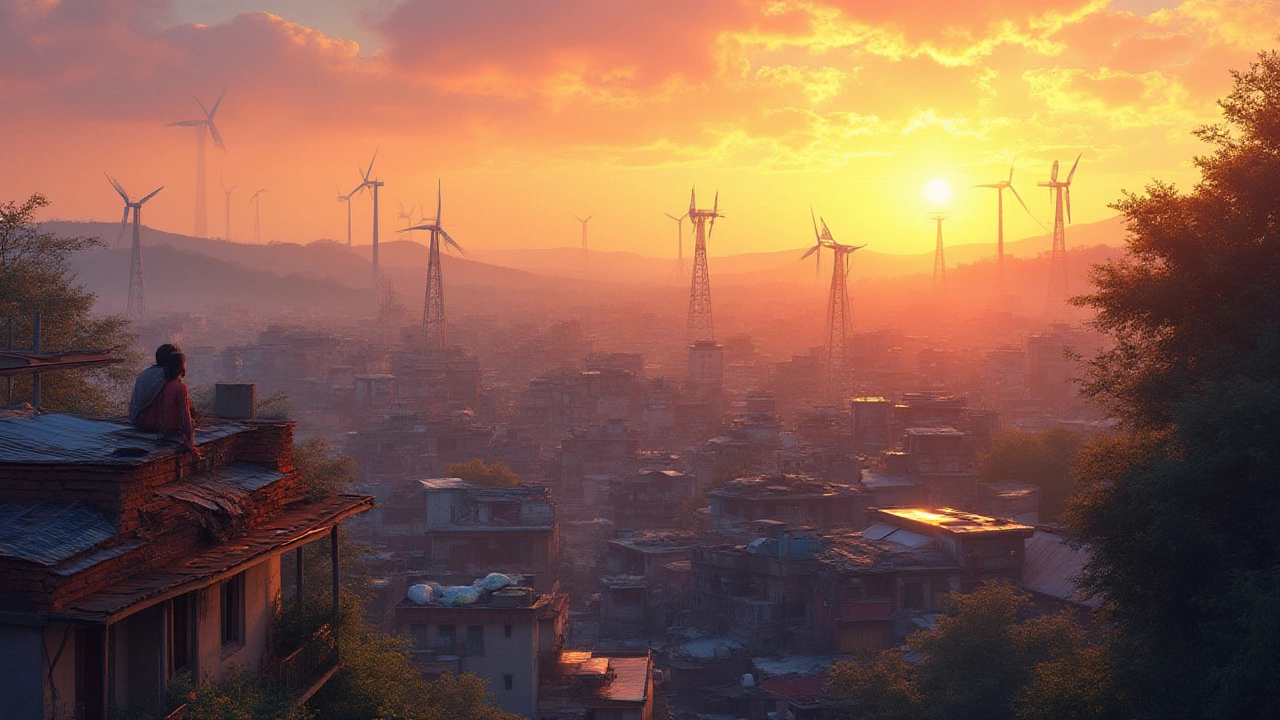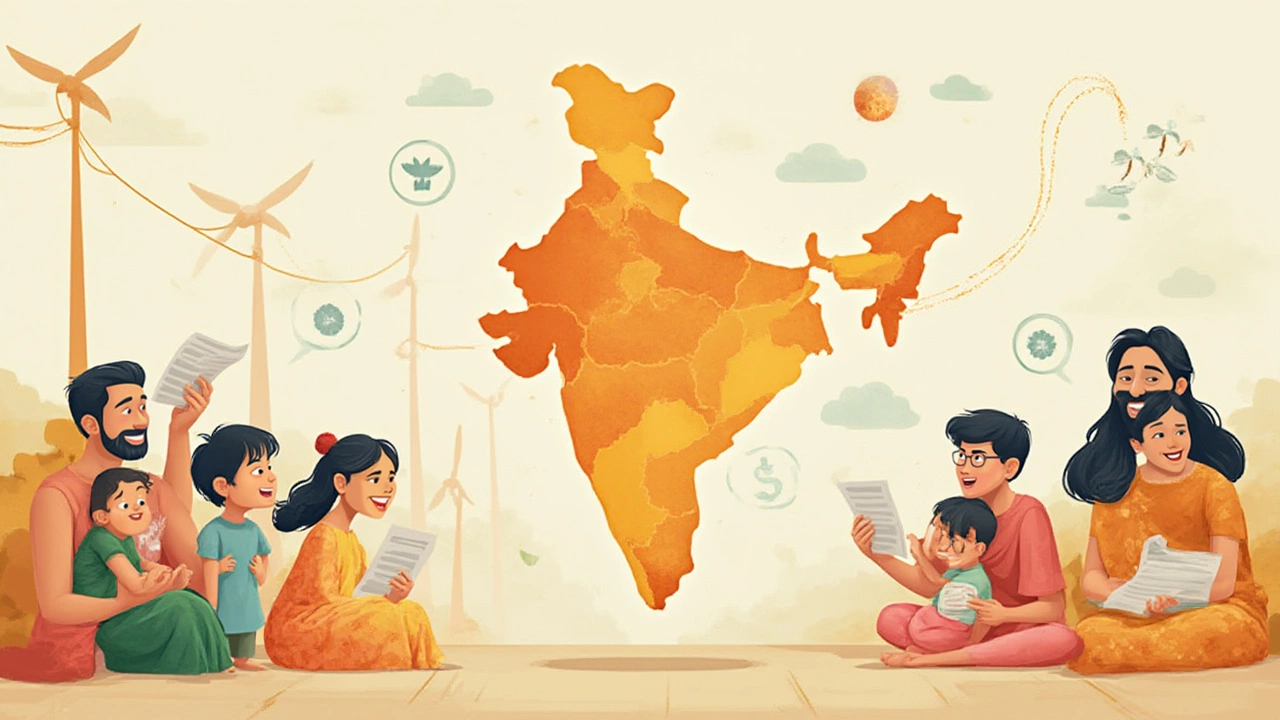Cheapest Energy Sources in 2024: Solar, Wind, and the Real Cost of Power
 Jul, 11 2025
Jul, 11 2025
You expect flipping a switch to cost pennies. But some folks pay four times less for their power than their neighbour a few countries over. Energy prices aren’t just about what comes out of your socket—they’re a wild mix of tech breakthroughs, market battles, government choices, and sometimes, pure luck. In 2024, the debate over the cheapest form of energy isn’t just nerdy trivia. It’s about household budgets, climate promises, and entire economies trying to stay afloat.
The Real Cost: How Energy Prices Are Calculated
Not all energy costs are created equal. If you're a regular person just reading your electric bill, you probably see a cost per kilowatt-hour (£/kWh if you're here in the UK). But behind that simple figure is a web of technicalities called "Levelized Cost of Energy" (LCOE). LCOE takes everything into account—from building the plant, running it, fixing it, to taking it apart at the end. This gives a fair comparison between coal, gas, solar, wind, nuclear, and whatever else someone tries plugging into the grid.
In 2024, researchers from the International Renewable Energy Agency (IRENA) published actual numbers (not industry fluffs). Their global averages in 2023, which everyone’s using as a springboard for debates this year, look like this: solar photovoltaic (solar PV) leads at roughly $0.049 per kWh, with onshore wind close behind at $0.050. Compare that with coal at $0.082 and natural gas at $0.068 per kWh. For nuclear? Try about $0.075 per kWh. And nobody’s even talking about oil anymore except in some remote corners of the world. A quick glance at a real-world table says it all:
| Energy Source | Global LCOE ($/kWh, 2023 avg) |
|---|---|
| Solar PV | 0.049 |
| Onshore Wind | 0.050 |
| Hydropower | 0.058 |
| Coal | 0.082 |
| Natural Gas | 0.068 |
| Nuclear | 0.075 |
So, by the numbers, solar power cost wins. But it’s not always that tidy. LCOE is an average, and it hides the wild price swings from region to region (or even hour to hour). Plus, LCOE doesn’t capture all the hidden costs: think grid upgrades, battery storage, or dealing with dark, windless nights. But for raw generation, nothing beats sun and wind anymore. Even big financial institutions and conservative energy analysts no longer doubt it: renewable energy is now the king of cheap.
Why Solar and Wind Keep Getting Cheaper
The last ten years have smashed expectations. Take solar: panels that cost almost $4 per watt in 2010 now cost under $0.25 per watt for utility-scale projects—an eye-watering 90% drop. Wind turbines have also quietly halved in price. But why did prices implode?
First, it's good old learning curves. Think of it like buying the first mega-flat-screen TV: nuts expensive, until factories churned them out by the million. As solar and wind scaled up, manufacturers found better ways to pump out the tech fast, cheap, and reliable. Supply chains matured. Installation crews got efficient. Some big Chinese companies got so massive that no one could touch their economies of scale. Plus, lots of governments quietly leaned on subsidies at the start, making renewables even more inviting until they could compete head-to-head.
But here’s a secret: market competition in renewables is a full-on dogfight now. Companies keep underbidding rival projects by shaving pennies off installation and maintenance. The International Energy Agency (IEA) says some solar farms in Saudi Arabia and India have delivered electricity for as low as $0.013 per kWh—so cheap it almost looks like a typo. Even European wind farms, battered by regulations and supply chain crises, continue to claw down their costs year after year. There’s no evidence the trend’s stopping. Storage, which used to be the Achilles' heel, is finally joining the race. Lithium-ion battery pack prices dropped 18% in a single year between 2022 and 2023. So now, cheap energy doesn’t have to stop when the sun goes down or the wind calms.

Who Wins? Cheapest Energy Depends on Where You Live
Anyone can say “solar is cheapest”; it’s the world map that keeps things spicy. If you call Norway, Iceland, or Quebec home, hydropower is still king on your electric bill. Homeowners in Texas have seen wind power outbid almost every fossil fuel plant, slashing local prices, sometimes even turning them negative on windy spring nights—yes, utilities paid people to use power.
Meanwhile, Australia has become a solar giant, not just for all that sun but because hitting the rooftop golden age turned every suburban home into a mini-power-plant. In 2024 the average Australian home pays under $0.20 per kWh due mostly to solar uptake. In sunnier bits of Africa, solar microgrids are breaking the back of diesel costs in off-grid villages. In India, wind and solar auctions set record-breaking low prices every year, recently reaching $0.015 per kWh.
However, if you live where politics favours fossil fuels, or the sun/wind situation sucks (hello, UK winters), you’ll still see a bigger share of your power come from gas, coal, or even imports. That’s changing slowly: In 2024, more than one-fifth of the world’s electricity comes from solar and wind, and in the wealthiest countries, that share’s much higher. The lesson? Your bill doesn’t just reflect energy costs; it’s an X-ray of geography, politics, and how much your government gambles on the future.
The Hidden Details: Storage, Grids, and When Cheap Isn’t Really Cheap
It’s easy to say, “Solar is cheap, job’s done.” But peek behind the curtain and things get complicated. The sun doesn’t shine at night; the wind can disappear for days. So now, battery storage is becoming the partner-in-crime for renewables. Energy storage costs dropped from $1,000 per kilowatt-hour a decade ago to under $130 in 2024. That’s epic. But, for whole countries needing 24/7 power? Storage still adds noticeable costs.
Then there’s the grid. Old power grids aren’t built for thousands of solar rooftops or wind farms wired in from the wilds. Upgrading them is expensive. The UK is dumping over £20 billion over the next five years into grid improvements mostly because renewables are pushing old wires to their limits. Add the price of storage and grid beef-ups, and the gap between the cost of solar panels and what you pay for electricity feels a bit less magical.
The real kicker? Some countries subsidize fossil fuels to keep the lights on for poorer citizens or to prop up uncompetitive industries. So in some places, coal might look artificially cheap on your bill. The International Monetary Fund says global fossil fuel subsidies (including those buried in tricky ways) hit $7 trillion in 2023. That’s like buying every Premier League club and still having cash left for a Champions League trophy. But the world’s moving closer to honest prices, and renewables keep shining even when you ditch those crutches. Tips for readers: if you’re considering home solar or battery installation, ask about true LCOE and check if your government offers hidden support for fossil fuels or renewables. It can flip the math.

What It Means for Your Wallet—and the Climate
Now for the bit that keeps both parents and planet-worriers (like me and my daughter Isha) up at night: what do these shifting energy prices mean for your wallet—and whether humans have half a shot at meeting climate goals?
On the ground, places moving fast on solar and wind tend to see their bills flatten or even dip. Germany used to be the poster child for high green energy costs, but its latest reports show a downward slide now that renewables are the majority of new additions. China, now installing more solar annually than the rest of the world combined, has seen wholesale electricity prices drop in provinces with big renewable bases. It’s not always passed on to consumers yet—governments sometimes play games with pricing, taxes, or infrastructure backlogs. But the direction is clear: as renewables take over, energy costs are more stable and less at the mercy of wild fuel prices or lurching geopolitical drama (remember last time gas prices shot up thanks to a pipeline crisis?).
The climate kicker is crystal—according to the United Nations and pretty much every credible climate scientist out there, the only way to hit net-zero targets is to make renewables the heart of the system. Cheap is good for wallets, but it’s even better if it means slashing greenhouse gas emissions. If you have the option to buy green power or invest in home solar—2024 is about as good as it gets. The tech’s never been more mature, and prices for both panels and batteries are likely at their lowest point in years. If you’re in a country where fossil fuels still rule, push your community leaders for change—because the numbers make it clear: renewables aren’t just for climate nerds anymore. They’re for anyone who likes to pay less each month for clean, home-grown power.